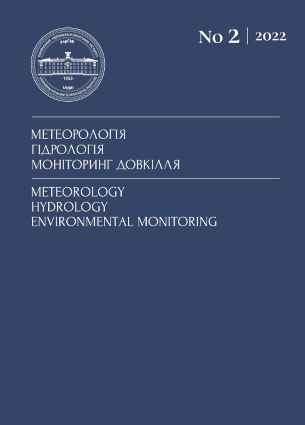PREDICTION OF GROUNDWATER FLOW TO THE SOUTH BUG RIVER USING ARTIFICIAL NEURAL NETWORKS AND REGRESSION EQUATIONS
Ukrainian Hydrometeorological Institute of the State Emergency Service of Ukraine and the National Academy of Sciences of Ukraine, Kyiv
https://orcid.org/0000-0002-5791-5354
Charnyi Dmytro Volodymyrovych
The institute of Environmental Geochemistry of National Academy of Sciences of Ukraine
https://orcid.org/
Rudoman Mykhaylo Mykolayovych
The institute of Environmental Geochemistry of National Academy of Sciences of Ukraine
https://orcid.org/
Abstract
References
1. Konoplyantsev, A.A., Semenov, S.M. (1974). Forecastingandmappingofthegroundwaterregime. Moscow: Nedra, 93-100. [In Russian]
2. Ruban, S.A., Shinkarevskyi, M.A. (2005). Hydrogeological assessments and forecasts of the underground water regime of Ukraine.Кyiv, 311-326. [In Ukrainian]
3. Shevchenko, A.L., Charnyi, D.V., Osadchyi, V.I., Ilchenko, A.O. (2021). GroundwaterflowintheSouthernBugRiverbasinunderconditionsofglobalwarming. Geologicaljournal, 3, 3-16.[In Ukrainian]
4. Shufranovych, M.A. (2014).A system of intellectual support for decision-making in conditions of uncertainty in the management of natural resources. Diss. can. technical scien.: 05.13.07. Ivano-Frankivsk, 199.[In Ukrainian]
5. Adamowski, J., Hiu Fung Chan, Prasher, S., Ozga-Zielinski, B., Sliusarieva, A. (2012). Comparison of multiple linear and nonlinear regression, autoregressive integrated moving average , artificial neural network and wavelet artificial neural network methods for urban water demand forecasting in Montreal, Canada.” Water resources research,48, # W01528.
6. Bailey, R.,Bieger, K., Arnold, J., Bosch, D. (2020). A new physically-based spatially-distributed groundwater flow module for SWAT+. Hydrology,7,75.
7. Bennett, C., Stewart, R.A., Beal, C.D. (2012). ANN-Based residential water end-use demand forecasting model. Expert Systems with Application, Vol. 40, 4, 1014-1023.
8. Bougadis, J., Adamowski, K., Diduch, R. (2005). Short-Term Municipal Water Demand Forecasting. Hydrological Processes, 19, 1, 137–48.
9. Ghiassi, M., Fa’al, F., Abrishamchi, A. (2017). Large Metropolitan Water Demand Forecasting Using DAN2, FTDNN, and KNN Models: A Case Study of the City of Tehran, Iran. Urban Water Journal, 14, 6,655–59. https://doi.org/10.1080/1573062X.2016.1223858.
10. Grossmann, A., Morlet, J. (1984). Decomposition of Hardy functions intosquare integrable wavelets of constant shape. SIAM. J. Math. Anal. 15,723-736.
11. Li,B., Rodell, M., Kumar, S., Beaudoing, H.K., Getirana, A., Zaitchik, B.F., deGoncalves, L.G., Cossetin, C. etal. (2019). Global GRACE data assimilation for groundwater and drought monitoring: Advances and challenges. Water Resour. Res.55, 7564–7586.
12. Pahlavan, R., Omid, M., Akram, A. (2012). Application of data envelopment analysis for performance assessment and energy efficiency improvement opportunities in greenhouses cucumber production. J. Agr. Sci. Tech. 14, 1465–75.
13. Perez-Valdivia, C., Sauchyn, D., Vanstone, J. (2012). Groundwater levels and teleconnection patterns in the Canadian Prairies. Water Resour. Search, 48(7).
14. Ram, A.P. (2022). Unsupervised Representation Learning of GRACE Improves Groundwater Predictions. Water, 14, 2947.
15. Rodriguez, R.H., Puig, V., Farias, R.L., Flores, J.J.(2017). Short-term demand forecast using a bank of Neural Network Models Trained Using Genetic Algorithms for the Optimal Management of Drinking Water Networks. J. Hydroinform,19. 1-16.
16. Rojas, R., Castilla-Rho, J., Bennison, G., Bridgart, R., Prats, C., Claro, E. (2022). Participatory and Integrated Modelling under Contentious Water Use in Semiarid Basins. Hydrology, 9, 49.
17. Rust, W., Holman, I., Bloomfield, J., Cuthbert, M., Corstanje, R. (2019). Understanding the potential of climate teleconnections to projectfuture groundwater drought. Hydrology and Earth System Sciences Discussions, 1–35.
18. Schumacher, M., Forootan, E., vanDijk, A.I., Schmied, H.M., Crosbie, R.S., Kusche,J., Döll,P. (2018). Improvingdroughtsimulationswithin the Murray-Darling Basin by combined calibration/assimilation of GRACE data into the WaterGAP Global HydrologyModel. Remote Sens. Environ.204, 212–228.
19. Shevchenko, O., Skorbun, A., Osadchyi, V., Osadcha, N., Grebin, V., Osypov, V. (2022). Cyclicities in the regime of groundwater and of meteorological factors in the basin of the Southern Bug River. Water,14(14), 2228.
20. Shin, M., Moon, S., Kang, K., Moon, D., Koh, H. (2020). Analysis of Groundwater Level Variations Caused by the Changesin Groundwater Withdrawals Using Long Short-Term Memory Network. Hydrology, 7,64.
21. Tiwari, Mukesh K., Adamowski, J. (2013). Urban water demand forecasting and uncertainty assessment using ensemble wavelet-Bootstrap-Neuralnet work models. Water resources research, 49. 6486–6507.
22. Van Loon, A.F. Hydrological drought explained. WIREs Water. (2015). Vol. 2, 4, 359-392.

